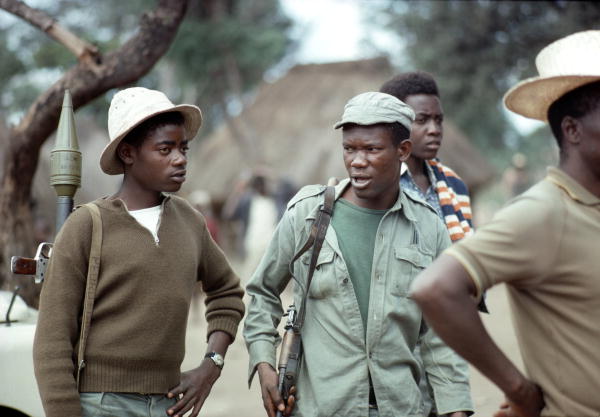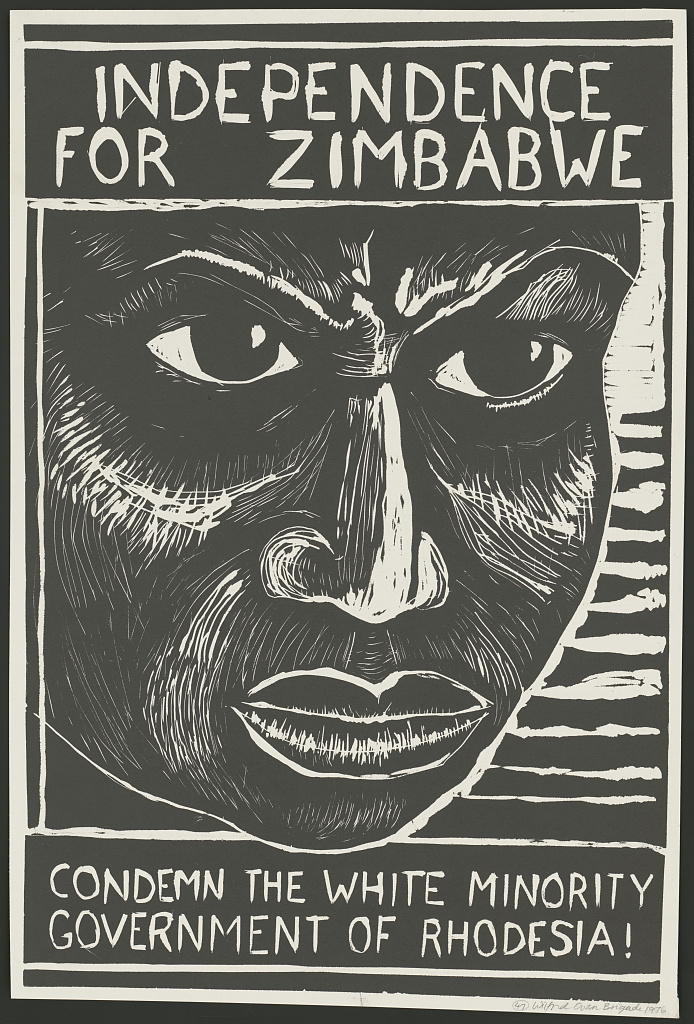The United States and Colonial Zimbabwe: Pan-African Linkages

In 1965, the racially-driven political crisis in the British self-governing colony of Southern Rhodesia (colonial Zimbabwe) entered a dramatic new stage when the territory’s white minority government, under the leadership of the Rhodesian Front (RF), proclaimed a treasonous Unilateral Declaration of Independence (UDI) in order to preserve white rule. The RF’s extremist racial policies forced colonial Zimbabwe’s pan-African connections to develop almost entirely in a state of exile. The party came to power in 1962, following the predominantly white electorate’s backlash against the more paternalist United Federal Party (UFP) which, at least nominally, was committed to an undefined but hopeful policy of racial “partnership.” The UFP rhetoric facilitated modestly more inclusive policies in the late 1950s and early 1960s that resulted in a more reciprocal exchange of contacts between Black people in the U.S. and Southern Rhodesia.
A relatively quiet but nonetheless significant two-way escalation of physical, intellectual, and cultural connections with Black America in the decade prior to UDI played an important role in shaping emerging nationalist resistance to Rhodesian settler rule. Black Rhodesians’ increasing awareness of struggles for racial justice in the U.S. encouraged resistance to white minority rule, particularly among the elites that stood to benefit the most from the gradual intensification of “partnership.” A number of prominent Black Rhodesians returned from visits to the U.S. in the late 1950s and early 1960s with an increased commitment to African nationalism or resolve to highlight racial injustice.
Ndabaningi Sithole, founding president of the Zimbabwe African National Union (ZANU), Zimbabwe’s current ruling party, constitutes the most prominent example of the impact of the United States in radicalizing the colony’s top tier of highly educated nationalist leaders. As a theological student in Massachusetts in the late 1950s, Sithole wrote a manifesto, African Nationalism, which argued the case for majority rule in Africa. The book expressed strong anti-colonial sentiments at a time when Black Rhodesian intellectuals were hesitant to openly confront the State. Its 1959 release inaugurated a swift trend in that direction, including the launch of Sithole’s own formal political career the following year.
Eager to win hearts and minds during the Cold War, the newly established U.S. consulate in the Southern Rhodesian capital of Salisbury awarded several State Department Leader Grants to former and active Black Rhodesian journalists to visit the U.S. These awards went to progressively more radical figures and resulted in the emergence of increasingly critical on-the-ground reporting of American race relations in the Black Rhodesian press.
Lawrence Vambe, an active journalist, received a Leader Grant in 1957. Although known for his moderate views, Vambe’s reports home about his U.S. sojourn expressed sentiments that his American benefactors would probably have preferred that he overlook. Urban Rhodesians followed Vambe’s visit in detail as he relayed tales of his travels from New York to California over the course of several months in “A Rhodesian in America,” a running column featured in the various titles owned by African Newspapers Limited, which catered to a predominantly Black readership. In addition to his interactions with African American owned businesses like the Johnson Publishing conglomerate, readers learned about Vambe’s denial of service at several restaurants in Utah (he said he had dealt with ‘much worse’ at home) and his impressions of residential segregation and Black economic marginalization in Washington, D.C.1
In 1960, Nathan Shamuyarira, a more outspoken journalist who became ZANU’s Secretary for External Affairs several years later, toured the U.S. on a Leader Grant. He spent extensive time in the American South and discussed political developments there much more critically than Vambe. Shamuyarira painted a gloomy picture of U.S. race relations consisting of “a Negro who is subservient to his white landlord, and a whiteman [sic] who cannot accept the Negro as an equal.” More optimistically, he concluded to the readers of the African Daily News that the white southerner’s “day for segregation is in its late afternoon.” He saw the sun begin to set first-hand while reporting from a sit-in in Atlanta, Georgia, where Martin Luther King Jr. was arrested.2 Shamuyarira’s portrayal of success in the overseas racial struggle was echoed in the dialogue of the domestic struggle as Rhodesian nationalists began to talk of obtaining majority rule in a matter of months.
Other sponsored visits came from private organizations seeking to strengthen U.S.-Africa ties. Herbert Chitepo, the colony’s first Black lawyer, toured the U.S. with his wife Victoria under the auspices of the Africa-America Institute in early 1960. Returning separately, each was quizzed by the African Daily News about the experience. Herbert spoke glowingly of his meetings with NAACP chapters and the support he received from future U.S. Supreme Court Justice Thurgood Marshall. Victoria noted that the couple closely followed the sit-in movement taking place during their stay. Herbert formally joined the nationalist struggle just weeks after returning from the U.S. A year later, his National Democratic Party (NDP) embarked on a campaign to integrate public facilities led by a team of “freedom sitters.”3 Colonial Zimbabwe’s exposure to Black America and American racism was not confined to the visits of select elites to the U.S. The presence of Black American culture and intellectuals in Southern Rhodesia ensured a more broad-based impact on the ground in southern Africa.
African-American culture received significant coverage in The African Parade, a monthly cultural magazine intended for a Black audience. Readers learned about the redemption of Paul Robeson, co-founder of the Council on African Affairs, as well as Harry Belafonte’s on-screen romance with a white woman at a time when the marriage of several Rhodesian Blacks to foreign whites was generating major controversy. More serious columns in daily papers by intellectuals like Tranos Makombe, a founding member of the NDP, educated readers about the role of western Blacks like W.E.B. Du Bois and Marcus Garvey in spreading pan-Africanism.4

More tangibly, a small but significant number of highly educated and socially conscious Black Americans visited the colony. The presence of these prominent figures, many of them women, contributed in part to the dismantling of perceived social barriers that made elite Black Rhodesians reluctant to confront racial injustice. In 1956, the American Friends Service Committee sponsored a two-week visit of Jean Fairfax, a Black educator and activist from Cleveland, Ohio.5 Her active social schedule included multi-racial gatherings hosted by the Capricorn Africa Society (CAS) and the Interracial Association, apostles of “partnership.” In these fora, Fairfax undoubtedly interacted with many of the Black intellectuals who joined the liberation struggle a few years later.
Other Black women traveled to Southern Rhodesia during this period. Dorothy Ferebee, the Director of the Howard University Medical Service and the second President of the National Council of Negro Women, visited Southern Rhodesia in August 1960. She lodged with the Chitepos (indicating the couple had formed strong links with D.C.’s Black community during their visit earlier in the year) following attendance at a conference in Ghana, a country whose political independence was routinely denigrated by Rhodesian whites. Adelaide Cromwell, a sociologist who had recently helped launch Boston University’s African Studies Program, traveled to the colony for several days in 1961 and boldly proclaimed to the press that the racial situation in the colony was increasingly resembling that of apartheid South Africa – a suggestion, anathema to local whites who saw themselves as being significantly more moderate on race relations than their southern neighbors.6
Unlike Ferebee and Cromwell, Tommie Anderson Samkange came to Southern Rhodesia not as a temporary visitor, but as a permanent resident. Originally from Jackson, Mississippi, Samkange met her husband, Stanlake Samkange, while the two were undertaking graduate studies at Indiana University. They married in the U.S. and in October 1958, Tommie settled in Salisbury with her husband. Her arrival set Southern Rhodesia’s social scene on fire, illustrating the extent of Black Rhodesia’s fascination with Black America. The Black press was replete with coverage of receptions across the colony in her honor.7 The Samkanges were the driving force behind the founding of Nyatsime College, a vocational institution. Through their connections it was opened in 1962 by Luther Foster, the fourth president of Tuskegee Institute. Extremely light-skinned, Foster was stopped in a Black suburb and asked to produce the pass that allowed him to be there as a white man. The incident made minor headlines and drew unfavorable attention to the colony’s restrictive laws.8
Despite the odds presented by geography and the crippling effects of discrimination, Black Americans and Black Zimbabweans were able to forge substantive links and draw mutual inspiration from their respective struggles for racial equality. In particular, Black Rhodesian intellectuals increasingly embraced political life following exposure to Black America(ns). The entry of these elites to nationalist politics constituted a turning point in the liberation struggle and marked the death knell of “partnership.”
The links between these groups pointed to the value of transnational solidarity and led to the eradication of the isolation that their oppressors relied upon. Contacts between Black Americans and Black Rhodesians in the 1950s and early 1960s at once contributed to the radicalization of the anti-colonial struggle while also presaging a deepening of the international alliances that helped hasten the end of minority rule in Southern Rhodesia.
- See “A Rhodesian in America,” The Bantu Mirror, October 26, 1957; “In New York”, The African Parade, September 1957. ↩
- “Segregatory Pattern in ‘Deep South’ is Being Threatened”, African Daily News, November 21, 1960. ↩
- “Chitepo Finds Great Progress in US Race Relations,” African Daily News, April 21, 1960; “Mrs. Chitepo is Back from America,” African Daily News, April 20, 1960. ↩
- Makombe, Tranos. “Pan – Africanism is a world force to Liberate Africa and Keep Balance Between East and West,” African Daily News, December 31, 1960. ↩
- “Jean Fairfax”, The African Parade, June 1956. ↩
- On Ferebee, see “Prominent Negress in Salisbury,” African Daily News, August 9, 1960; On Cromwell, see “Negro Visitor,” African Daily News, August 11, 1961. ↩
- “Between You and Me,” The African Parade, January 1959. ↩
- “Wrap Up of Events During the First Month of the Ban on ZAPU,” October 19, 1962. RG 59, Box 1695, Folder 745c.00/10-162; US National Archives II, College Park, MD. ↩
